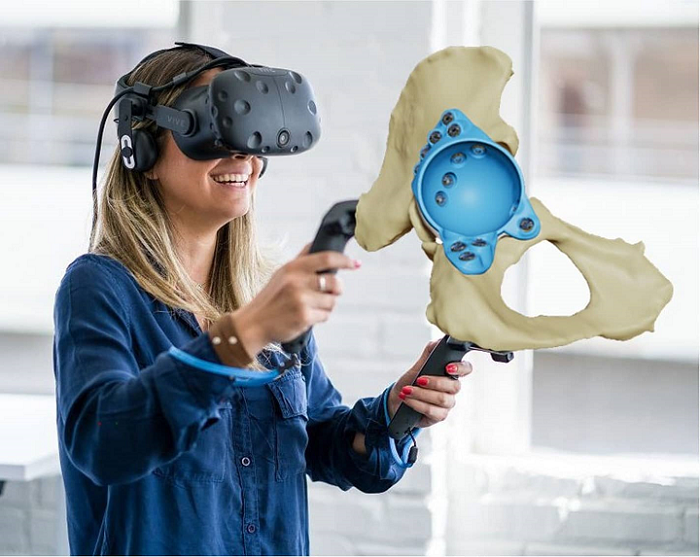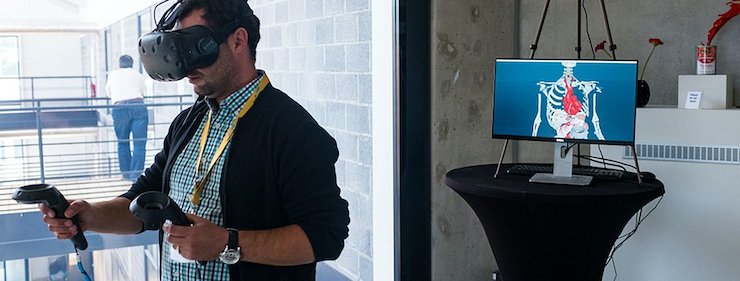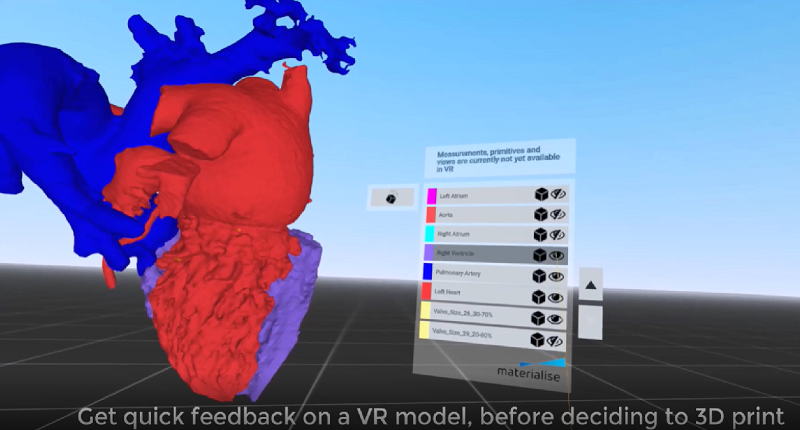Global 3D printing leader Materialise (Nasdaq: MTLS) has been providing solutions for medical applications for several years now, becoming the first company to receive FDA clearance for the diagnostic use of its 3D printed anatomical model software in 2018, acquiring Brazilian medical device manufacturer Engimplan last year, and receiving CE Marking Certification for most of its personalized orthopedic and cranio-maxillofacial (CMF) products just last month. At the recent virtual RSNA Annual Meeting, the company announced that it had integrated virtual reality (VR) capabilities into its Materialise Mimics 3D modeling software.
Its new Mimics VR Viewer adds extra visualization, which will be helpful for the purposes of medical planning. Over the last few years, the use of VR technologies in the medical field has grown more popular, with anatomical visualization applications prevalent in surgical planning, research, patient engagement, and training. The interactive VR environment in the online Mimics Viewer platform complements 3D printed medical models, which allows physicians and engineers to collaborate more efficiently; this will be especially helpful when it comes to remote planning sessions.
“3D printed anatomical models continue to provide irreplaceable value for doctors in the planning and communication of complex cases. As VR technologies become more seamless, the technology will have an important complementary role as a faster, low cost option for interactive models,” said Bryan Crutchfield, vice president and general manager, Materialise North America. “The interactive nature of a VR environment opens new doors for planning, education and communication and allow physicians to easily address more complex cases through personalized planning.”
According to Materialise, current VR applications are often “limited” by a number of issues, including the need to wear headsets that are attached to a physical and computer space, as well as a lack of good technical training to use VR solutions in the workflow. But the company says that the accessible VR experience offered by its new Mimics Viewer is “the first to remove tethering restrictions to ensure compatibility” among several VR devices. This means that teams can take on and plan much more complex cases, as several viewers are able to remotely access the VR environment.
Simply put, the Materialise Mimics Viewer is an online platform optimized for both mobile and desktop users. Someone on the receiving end can conveniently view your 3D patient models, device designs, and planning notes through a user-friendly interface, and its digital tools can help clinicians develop customized treatments through better depth and proportion perception. Materialise says that users can also easily maintain control and traceability in the VR environment, so sensitive patient information won’t be compromised.
The features in the new Mimics VR Viewer are optimal for a cloud-based medical planning environment, with receivers able to not only view your 3D models, but also use a contour overlay of the models in order to compare them to the original medical image data. Physicians can provide feedback and take measurements, and you can even share patient cases with another user who does not have access to Mimics Innovation Suite, Mimics inPrint, or Mimics Enlight license.
The new Materialise Mimics VR Viewer doesn’t require any additional software installation to use, and works with most common, inexpensive headsets. Medical organizations that already use the digital workflow to segment 3D medical images for printing will be able to, as the company put it, “extend their digital models to VR headsets,” so users can directly access the cases in a secure environment without having to jump through a lot of hoops or purchase and install more modeling tools or software.
(Sources: TCT Magazine, Materialise / Images: Materialise)
Subscribe to Our Email Newsletter
Stay up-to-date on all the latest news from the 3D printing industry and receive information and offers from third party vendors.
You May Also Like
IperionX Inks 10-Year Deal with Wisconsin Manufacturer for 80 Metric Tons of Titanium Per Year
IperionX, the Charlotte-based supplier of sustainable titanium powders used for additive manufacturing (AM) and metal injection molding (MIM), has signed a ten-year deal with United Stars, a group of industrial...
Gastronology Launches Industrial Production of 3D Printed Food for Dysphagia Patients
Food 3D printing has, in many ways, been an additive manufacturing (AM) segment looking for the right business case. While some applications are beautiful and others may or may not...
Lockheed Martin Leads $3M Investment in Q5D’s Electronics 3D Printing System
Q5D, an original equipment manufacturer (OEM) of robotic arm, hybrid additive manufacturing (AM) systems used for wire harness production, has closed a $3 million investment round. The investment arm of...
3D Printing News Briefs, April 6, 2024: Depowdering, Cybertruck Door Handles, & More
In today’s 3D Printing News Briefs, ioTech’s digital manufacturing CLAD technology is opening up opportunities for microelectronics and additive manufacturing. Hexagon and Raytheon Technologies commercially released the Simufact Additive Process...


































